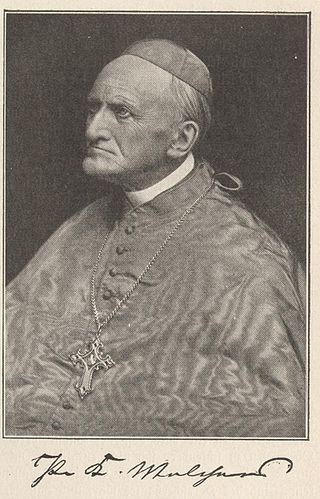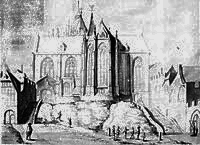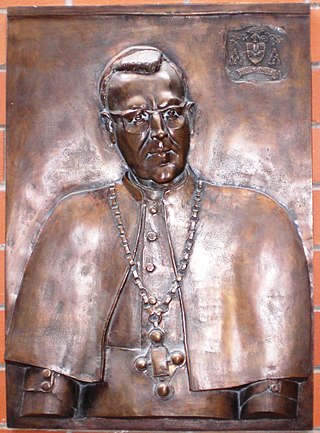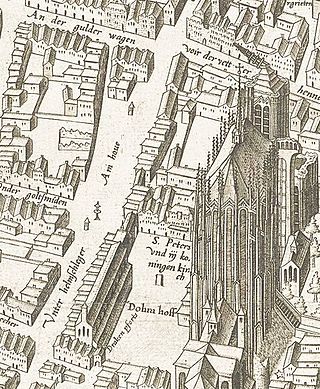Related Research Articles

Cologne Cathedral is a cathedral in Cologne, North Rhine-Westphalia belonging to the Catholic Church. It is the seat of the Archbishop of Cologne and of the administration of the Archdiocese of Cologne. It is a renowned monument of German Catholicism and Gothic architecture and was declared a World Heritage Site in 1996. It is Germany's most visited landmark, attracting an average of 20,000 people a day. At 157 m (515 ft), the cathedral is the tallest twin-spired church in the world, the second tallest church in Europe after Ulm Minster, and the third tallest church of any kind in the world.

The History of Cologne covers over 2000 years of urban history. In the year 50, Cologne was elevated to a city under Roman law and named "Colonia Claudia Ara Agrippinensium"; since the Frankish rule it is known as Cologne. The city became an influential merchant stronghold in the early Middle Ages due to its location on the Rhine, which allowed the most seasoned Cologne wholesalers to control the flow of goods from northern Italy to England. The archbishops promoted the perception of "Holy Cologne" when they developed the city to the capital of their Electorate of Cologne; to this end, they had both the semicircular city wall and the Gothic cologne cathedral built as a demonstration of power. In the 15th century, Cologne was able to shake off archiepiscopal rule and, as a Free Imperial City, enabled the burgher ruling class to achieve great splendor, visibly documented by the Cologne School of Painting. After the Thirty Years' War, however, the city's development stalled. Only after French occupation when in 1815, Cologne was incorporated into Prussia, the city experienced a steady upswing borne by industrialization. In 1880, the cathedral was completed as a national monument of German imperial unity providing the city with its well-known landmark. Extensive devastation in the Second World War was followed by decades of reconstruction, which only slowly restored Cologne to its emblematic urban panorama on the Rhine through the efforts of urban repair. Today with more than one million inhabitants, Cologne is the fourth largest city in Germany. It is primarily marketed as an event city, with Cologne Carnival being perceived as the biggest tourist attraction.

The Prince-Archbishopric of Bremen — not to be confused with the modern Archdiocese of Hamburg, founded in 1994 — was an ecclesiastical principality (787–1566/1648) of the Holy Roman Empire and the Catholic Church that after its definitive secularization in 1648 became the hereditary Duchy of Bremen. The prince-archbishopric, which was under the secular rule of the archbishop, consisted of about a third of the diocesan territory. The city of Bremen was de facto and de jure not part of the prince-archbishopric. Most of the prince-archbishopric lay rather in the area to the north of the city of Bremen, between the Weser and Elbe rivers. Even more confusingly, parts of the prince-archbishopric belonged in religious respect to the neighbouring Diocese of Verden, making up 10% of its diocesan territory.

The Archbishop of Cologne is an archbishop governing the Archdiocese of Cologne of the Catholic Church in western North Rhine-Westphalia and is also a historical state in the Rhine holding the birthplace of Beethoven and northern Rhineland-Palatinate in Germany and was ex officio one of the Prince-electors of the Holy Roman Empire, the Elector of Cologne, from 1356 to 1801.

Anno II was Archbishop of Cologne from 1056 until his death. From 1063 to 1065 he acted as regent of the Holy Roman Empire for the minor Emperor Henry IV. Anno is venerated as a saint of the Catholic Church.

Josef Richard Frings, was a German Cardinal of the Catholic Church. He served as Archbishop of Cologne from 1942 to 1969. Considered a significant figure in Catholic resistance to Nazism, he was elevated to the cardinalate in 1946 by Pope Pius XII.

Heribert of Cologne, also known as Saint Heribert, was a German Roman Catholic prelate who served as the Archbishop of Cologne from 999 until his death. He also served as the Chancellor for the Emperor Otto III since 994. He also collaborated with Henry II, Holy Roman Emperor with whom relations were strained though were strengthened over time.
Warin was the Archbishop of Cologne, Germany, from 976 to 984.

The Great Saint Martin Church is a Romanesque Catholic church in Cologne, Germany. Its foundations rest on remnants of a Roman chapel, built on what was then an island in the Rhine. The church was later transformed into a Benedictine monastery. The current buildings, including a soaring crossing tower that is a landmark of Cologne's Old Town, were erected between 1150-1250. The architecture of its eastern end forms a triconch or trefoil plan, consisting of three apses around the crossing, similar to that at St. Maria im Kapitol. The church was badly damaged in World War II; restoration work was completed in 1985.

Johannes von Geissel was a German Catholic Archbishop of Cologne and Cardinal from the Electorate of the Palatinate.

Paul Melchers was a Cardinal and Archbishop of Cologne. At the height of the Kulturkampf he took refuge in the Netherlands.

St. Maria ad Gradus is the name of a former church located East of the Cathedral of Cologne, Germany, situated between the cathedral and the Rhine.
Frederick of Saxe-Lauenburg (1554–1586), was a cathedral canon at Strasbourg Minster, chorbishop at Cologne Cathedral and cathedral provost (Dompropst), a function including the presidency of the chapter, at Bremen Cathedral.

Ruprecht of the Palatinate was the Archbishop and Prince Elector of Cologne from 1463 to 1480.

Henry of Saxe-Lauenburg was a Prince-Archbishop of Bremen, then Prince-Bishop of Osnabrück, then Prince-Bishop of Paderborn.

Saint Mary's Cathedral in Hamburg was the cathedral of the ancient Roman Catholic Archdiocese of Hamburg, which was merged in personal union with the Diocese of Bremen in 847, and later in real union to form the Archdiocese of Hamburg-Bremen, as of 1027.

St. Patrokli is a Roman Catholic parish and church in Soest, Germany. The church is of great significance in the history of architecture as it is the epitome of Romanesque architecture in Westphalia. As a result, it is known as St.-Patrokli-Dom. It holds relics of its patron saint Patroclus of Troyes from 954. It was the church of the canonical foundation of St. Patroclus, which existed from the 10th century until its abolition in 1812. Since 1823 the church has been the parish church of the St. Patrokli parish in the diocese of Paderborn. In 1859 it was promoted to the rank of provost church.

The Altenberger Dom is the former abbey church of Altenberg Abbey which was built from 1259 in Gothic style by Cistercians. Listed as a cultural heritage, it is located in Altenberg, now part of Odenthal in the Rheinisch-Bergischer Kreis, North Rhine-Westphalia, Germany. Until 1511, the church was the burial site of counts and dukes of Berg and the dukes of Jülich-Berg.

Wilhelm Kempf was a German Catholic theologian who served between 1949 and 1981 as Bishop of Limburg. After the Second World War, he introduced the reforms of the Second Vatican Council to his Diocese.

The Reifferscheider Hof or Linneper Hof was a manor of the Reifferscheid, Linnep, Sayn-Wittgenstein and Grafschaft Neuenahr families in erbvogteilichen Hacht district on the Domhof in Cologne, which was laid down in the 1740s. It was inhabited by members of the Cologne Cathedral Chapter and was a emphyteusis of the cathedral monastery. Today, the area is part of the grounds of the Romano-Germanic Museum.
References
- ↑ G Catholic website, Metropolitan Archdiocese of Cologne
- ↑ Catholic Hierarchy website, Archbishop Everger profile
- ↑ N. A. Holtschuppen, ‘Zur Gründungsgeschichte des Klosters St. Vitus in Mönchengladbach: Die Necrologeinträge für die Gründer Baldricus, Gero und Sandrad’, in U. Ludwig and T. Schilp (eds), Mittelalter an Rhein und Maas: Beiträge zur Geschichte des Niederrheins (Münster, Waxmann, 2004), pp. 69-85.